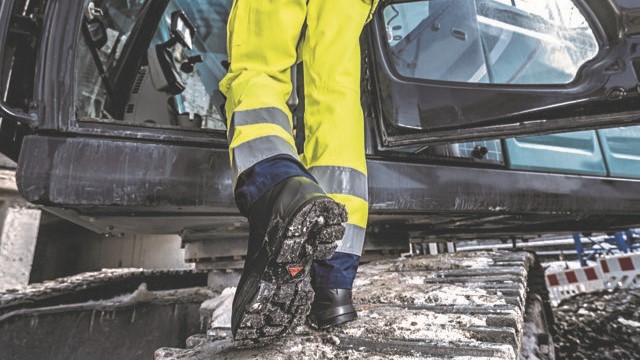The introduction of EN ISO 20345:2022 may seem overwhelming for health & safety professionals, but there’s no need to panic, writes uvex’s Clair Weston.
Safety footwear is a crucial part of PPE. Since March 2023 safety shoes and boots have been subject to the updated EN ISO 20345:2022 standard. That has presented some cause for concern for safety professionals whose staff are still wearing footwear produced under EN ISO 20345:2011. However, there is no need to worry. Here is a simple overview of what the new standard means and the action – if any – you need to take. For further information, see the uvex White Paper: Demystifying the new safety footwear standard: A simple guide to ENISO20345:2022
Basic requirements
Most basic requirements remain the same under the new standard. EN ISO 20345:2022 still mandates the height, ergonomics and comfort of the footwear which are crucial to ensure adequate protection, fit and overall ‘wearability’. It determines the resistance, non-toxicity and properties of the materials used in the sole and shoe/boot upper. The toe cap must also meet minimum requirements, including passing a drop test equivalent to 20kg from a height of approximately one metre.
However, the slip resistance is the most significant change and has now been added as a basic requirement for all safety footwear. Shoes/boots must meet a standard similar to the old ‘SRA’ certification with a test involving sodium lauryl sulphate on ceramic tiles. No additional markings are shown for this. However, if the footwear also passes a test with glycerol on a ceramic tile – much like the old ‘SRB’ certification – they can be marked with ‘SR’.
Additional requirements
Depending on workplace hazards, there may be additional requirements beyond the basics. Footwear that offers protection in these specific areas are marked with letter-based codes. Under the 2022 standard, the range of additional requirements has gone from 12 to 18.
Changes include the introduction of ‘LG’ to indicate heel grip for ladders. This additional certification is based on the ladder grip test that is standard for footwear intended for firefighters, although highly relevant to construction related trades.
The new footwear standard now includes resistance to hydrocarbons, indicated by an ‘FO’ marking, as an additional test for environments with hazards such as oil and petrol. Previously, ‘FO’ – resistance to fuel oil – was a basic requirement for most safety footwear, except those with an open heel (SB).
Some of the additional requirements under the 2012 standard have expanded and evolved. Under the new standard, safety footwear that protects against nail penetration is marked differently: ‘P’ is used for metallic soles tested with a 4.5 mm nail, ‘PL’ for non-metallic soles tested with a 4.5 mm nail, and ‘PS’ for non-metallic soles tested with a 3 mm nail, offering higher protection due to the smaller diameter nail’s higher pressure. This expands on the old standard, where all such footwear was simply marked with ‘P’.
The EN ISO 20345:2011 standard used ‘WRU’ for shoes/boots with water-resistant uppers, but this didn’t guarantee waterproof footwear. The 2022 standard replaces ‘WRU’ with ‘WPA,’ indicating that the footwear allows some water penetration and absorption, suitable for conditions where feet aren’t submerged. ‘WR’ is now used for truly waterproof shoes.
Protection classes
Safety footwear is divided into different protection classes depending on the requirements fulfilled. This has become a little more complicated under the new standard. Under EN ISO 20345:2011, the protection levels were divided into six classes: SB, S1, S2, S3, S4 and S5. Now, there are eight main protection classes: SB, S1, S2, S3, S4, S5, S6 and S7. The two new protection classes – S6 and S7 – are waterproof in the line with the new ‘WR’ certification.
In addition to the new classes, the class codes may also be followed by ‘P’, ‘L’ (or ‘PL’) and ‘S’ (or ‘PS’) to indicate additional perforation resistance in line with the ‘P’, ‘PL’ and ‘PS’ certifications.
Taking action
The new standard has brought numerous improvements, however, as with any change to standards, it also potentially makes life more complicated for those working in PPE procurement, especially until all involved are familiar with the changes. The good news is that most will not need to take any action at this stage.
While EN ISO 20345:2022 is now in place, we are still in a transition extending up to five years, allowing for a gradual integration of the new standard. Customers can therefore expect to encounter safety footwear certified under either the 2011 or 2022 standard until November 2029. During this time, manufacturers with valid certificates can still produce footwear under the 2012 standard and it is still perfectly legal to purchase them. If you bought your footwear from a reputable supplier and it has been performing effectively and well maintained, it should not need to be replaced.
You should, however, consider buying shoes produced under the 2022 standard if you carry out a new risk assessment and identify new workplace hazards that require safety footwear. You should also look to replace any safety shoes or boots that have degraded due to wear and tear.



